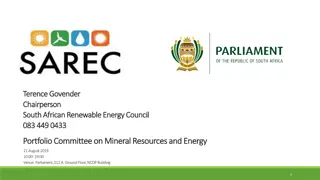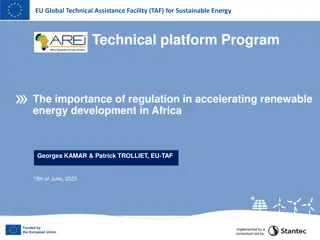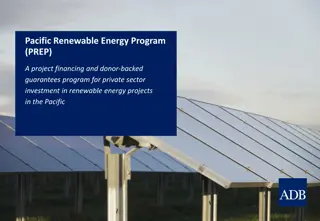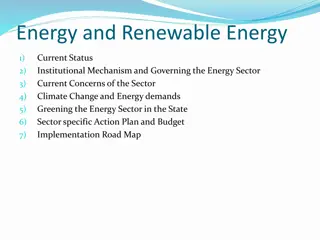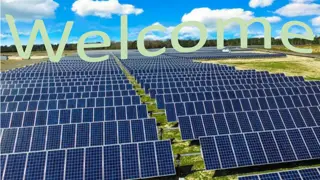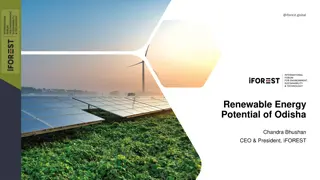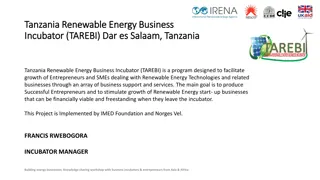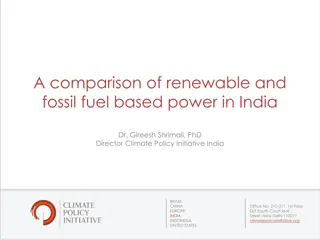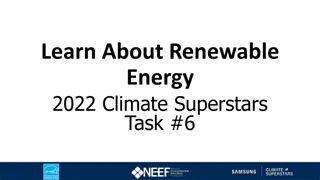Lifecycle Analysis of Renewable Energy Facilities in Virginia
A comprehensive report presented at the Virginia Energy Summit discusses the analysis of renewable energy facilities' life cycle, legislative background, required analysis topics, key findings, and recommendations, emphasizing feasibility, costs, recycling opportunities, and potential impacts on underground infrastructure and ecosystems. The report highlights findings related to solar and wind infrastructure, underground infrastructure post-decommissioning, impacts on farming and wetlands, and provides recommendations for resource sharing and attracting recycling facilities to Virginia.
Download Presentation

Please find below an Image/Link to download the presentation.
The content on the website is provided AS IS for your information and personal use only. It may not be sold, licensed, or shared on other websites without obtaining consent from the author.If you encounter any issues during the download, it is possible that the publisher has removed the file from their server.
You are allowed to download the files provided on this website for personal or commercial use, subject to the condition that they are used lawfully. All files are the property of their respective owners.
The content on the website is provided AS IS for your information and personal use only. It may not be sold, licensed, or shared on other websites without obtaining consent from the author.
E N D
Presentation Transcript
1 Task Force Report on Lifecycle Analysis of Renewable Energy Facilities Virginia Energy Summit July 19, 2023
2 Legislative Background Legislation: House Bill 774 / Senate Bill 499 from 2022 GA session Task: Analyze the life cycle of renewable energy facilities, including solar, wind, and battery storage components Agencies: SCC-led (in consultation with DEQ & Virginia Energy) 3rd Party Facilitator: Keystone Policy Center Report Due Date: May 1, 2023
3 Required Analysis Topics 1. Feasibility, costs, recycling and salvage opportunities, waste strategies, and liability for the decommissioning of materials 2. Potential impacts of underground infrastructure post-decommissioning 3. Potential impacts of the life cycle on farming, forestry, and sensitive wetlands 4. Potential beneficial economic impact of solar, wind, and battery storage development
4 1. Feasibility, costs, recycling and salvage opportunities, waste strategies, and liability for the decommissioning of materials Key Findings 1. Solar and wind infrastructure are not yet reaching end-of-life 2. Most near-term recycling need is for solar 3. Most wind turbine components can be recycled 4. Virginia statutes exist relative to decommissioning plans
5 Feasibility, costs, recycling and salvage opportunities, waste strategies, and liability for the decommissioning of materials Recommendations 1. Share/develop pertinent resources for the general public and elected officials 2. Attract recycling and/or circular economy-oriented facilities to Virginia
6 2. Potential impacts of underground infrastructure post-decommissioning Key Findings 1. Solar decommissioning underground structures may be left in place 2. Onshore wind turbine foundations underground structures are generally left in place
7 Potential impacts of underground infrastructure post-decommissioning. Recommendations 1. Perform state-specific research on impacts of underground infrastructure 2. Implement information sharing
8 3. Potential impacts of the life cycle on farming, forestry, and sensitive wetlands Key Findings 1. VCEA s 16,100 MW goal for solar and onshore wind has certain land impacts 2. Land is available in Virginia for solar with caveats 3. State & federal regulations exist addressing sensitive wetlands 4. There are other determining factors regarding siting
9 Potential impacts of the life cycle on farming, forestry, and sensitive wetlands Key Findings (contd.) 1. Rooftop solar land use impacts 2. Onshore wind land use impacts 3. Offshore wind land use impacts 4. Battery storage land use impacts
10 Potential impacts of the life cycle on farming, forestry, and sensitive wetlands Recommendations 1. Additional tools are needed 2. Additional research is needed
11 4. Potential beneficial economic impact of solar, wind, and battery storage development. Key Findings 1. Renewable energy development nationwide is likely to grow 2. Renewable energy sources provide certain advantages 3. There are tax revenue impacts 4. Cannot readily quantify exact job gains and ratepayer savings
12 Potential beneficial economic impact of solar, wind, and battery storage development. Key Findings (contd.) 1. Battery storage complements and enables penetration of wind and solar. Also provides grid benefits as a viable standalone technology 2. Energy storage can reduce costs for ratepayers 3. Energy storage can provide grid stability
13 Potential beneficial economic impact of solar, wind, and battery storage development. Recommendations 1. Share and/or develop additional resources 2. Explore policies & partnerships for job training/workforce development
14 Questions? Link to the Task Force Report: https://rga.lis.virginia.gov/Published/2023/RD189









